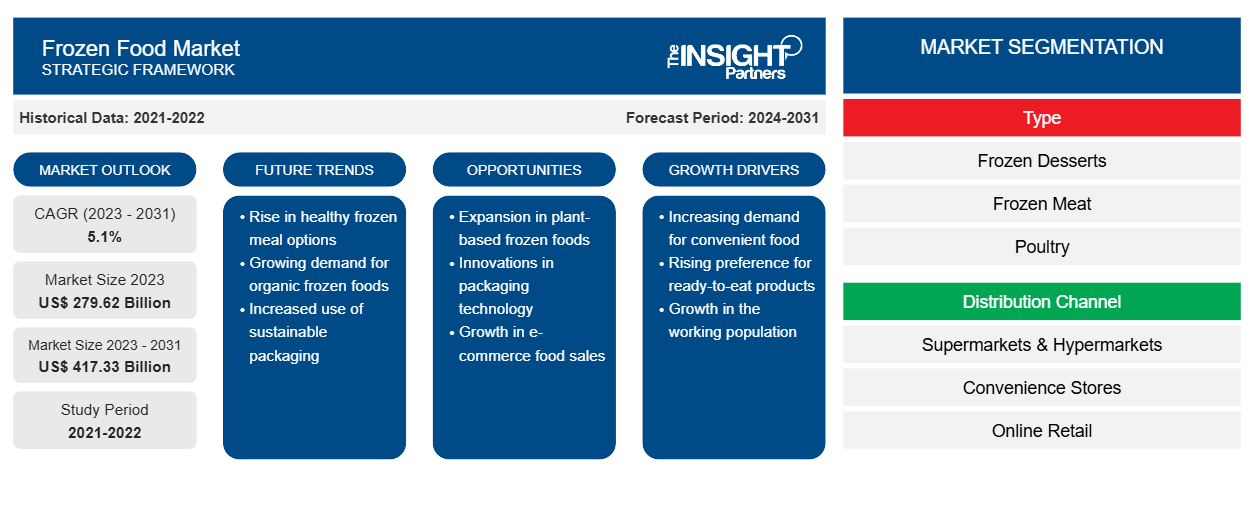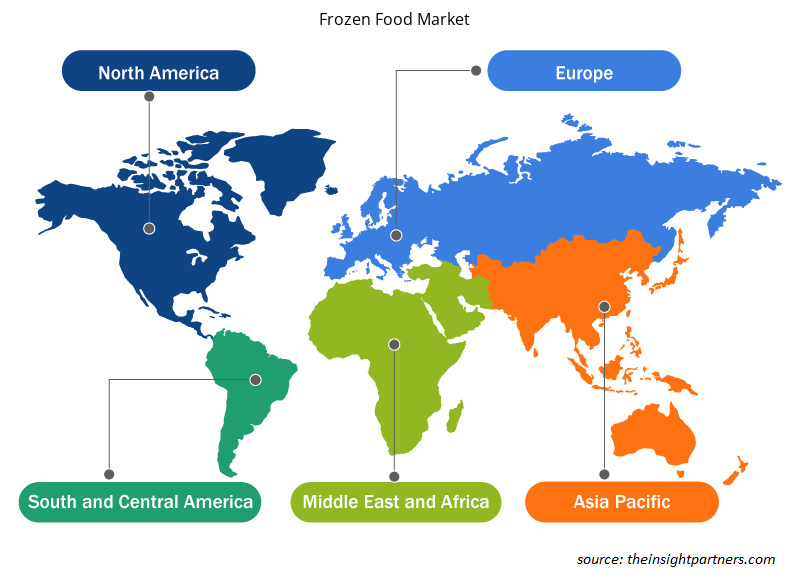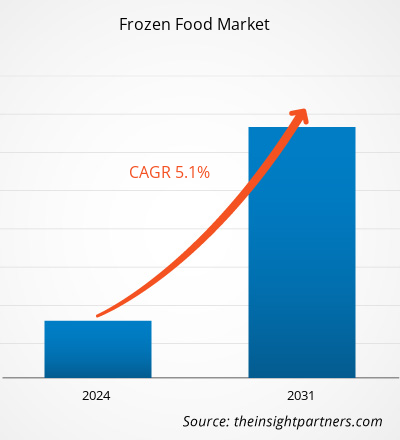Si prevede che il mercato degli alimenti surgelati raggiungerà i 444,22 milioni di dollari entro il 2031, rispetto ai 295,39 milioni di dollari del 2024; si prevede che registrerà un CAGR del 6,0% durante il periodo di previsione. Il veganismo ha acquisito un notevole slancio negli ultimi anni. I consumatori sono fortemente propensi a preferire i prodotti a base vegetale, poiché li ritengono più sani rispetto ai prodotti convenzionali. Inoltre, la crescente consapevolezza in materia di tutela degli animali e sostenibilità ambientale sta contribuendo alla popolarità di questi prodotti alimentari. La diffusione dell'ondata vegana in tutto il mondo sta influenzando notevolmente le innovazioni nel mercato degli alimenti surgelati.
Analisi del mercato degli alimenti surgelati
Negli ultimi anni, lo stile di vita delle persone in tutto il mondo si è evoluto radicalmente. A causa dei ritmi di lavoro frenetici, è aumentata la dipendenza delle persone da prodotti che consentono di risparmiare tempo e fatica. L'aumento del consumo di cibi pronti di alta qualità è una delle tendenze più importanti nel settore alimentare. I cibi pronti, come snack surgelati, pasti surgelati, salumi e prodotti pronti al consumo, consentono ai consumatori di risparmiare tempo e fatica legati all'acquisto degli ingredienti, alla preparazione e alla cottura dei pasti, al consumo e alle attività post-pasto. Lo sviluppo e la popolarità di questi prodotti alimentari sono attribuiti a numerosi cambiamenti sociali; i più significativi sono il crescente numero di famiglie più piccole e l'aumento della popolazione dei Millennial in tutto il mondo. A causa dei ritmi di lavoro frenetici, i Millennial preferiscono gestire il proprio tempo in modo efficiente, piuttosto che sprecarlo in attività noiose. Pertanto, sono più propensi a spendere denaro in cibi pronti. Questi fattori stanno aumentando significativamente la domanda di cibi pronti tra i consumatori, favorendo di conseguenza la crescita del mercato dei surgelati.
Panoramica del mercato degli alimenti surgelati
Gli alimenti surgelati includono gelati, yogurt gelato, carne surgelata, pesce surgelato, piatti pronti surgelati, snack, antipasti, zuppe, frutta e verdura. Questi prodotti vengono conservati congelandoli a una temperatura di circa -25 °C. I surgelati non contengono conservanti artificiali, il che li rende più sani di altri alimenti trasformati. Inoltre, possono essere facilmente conservati nei congelatori domestici con una temperatura di -25 °C. La crescente domanda di cibi pronti, dovuta allo stile di vita frenetico delle persone, sta trainando la crescita del mercato dei surgelati. Inoltre, la rapida urbanizzazione, l'aumento del reddito pro capite e il cambiamento dello scenario della vendita al dettaglio sono alcuni dei fattori chiave che guidano la crescita del mercato dei surgelati.
Personalizza questo report in base alle tue esigenze
Riceverai la personalizzazione gratuita di qualsiasi report, incluse parti di questo report, analisi a livello nazionale, pacchetto dati Excel e potrai usufruire di fantastiche offerte e sconti per start-up e università.
Mercato degli alimenti surgelati: approfondimenti strategici

-
Scopri le principali tendenze di mercato di questo rapporto.Questo campione GRATUITO includerà analisi di dati che spaziano dalle tendenze di mercato alle stime e alle previsioni.
Fattori trainanti e opportunità del mercato degli alimenti surgelati
La crescita dell'e-commerce favorisce il mercato
Le persone preferiscono sempre di più le piattaforme di vendita al dettaglio online per l'acquisto di alimenti surgelati. Secondo l'American Frozen Food Institute, le vendite online di prodotti alimentari surgelati sono aumentate del 75% nel 2020. Le vendite online di alimenti e bevande sono aumentate significativamente durante la pandemia a causa della chiusura dei negozi fisici e dell'imposizione di restrizioni sociali da parte dei governi. Poiché gli spostamenti delle persone sono stati limitati dai lockdown e le persone sono state costrette a lavorare da casa, si è verificato un sostanziale passaggio allo shopping online. Inoltre, sconti consistenti, ampia disponibilità di diversi marchi sotto lo stesso tetto e opzioni di consegna a domicilio sono stati altri fattori importanti che hanno spinto i consumatori a concentrarsi sullo shopping online. Con la crescente penetrazione dell'e-commerce in diverse aree geografiche, i produttori di alimenti surgelati come Kellogg's Company e Conagra Brands stanno ampliando la loro presenza online vendendo i loro prodotti attraverso note piattaforme di e-commerce come Amazon.com, Lidl e Walmart. Questo fattore contribuisce alla crescita del mercato degli alimenti surgelati eliminando la dipendenza dai negozi al dettaglio offline.
Iniziative di sviluppo strategico da parte dei produttori: un'opportunità
I produttori di alimenti surgelati stanno investendo in modo significativo nell'innovazione di prodotto per ampliare la propria base clienti e soddisfare le nuove tendenze di consumo. Stanno lanciando prodotti senza glutine, a base vegetale, senza zucchero, biologici e con etichetta pulita, nonché prodotti adatti a una dieta chetogenica, che soddisfano le diverse esigenze dei consumatori. Ad esempio, nell'agosto 2021, Real Good Foods Company, un nome noto nel settore degli alimenti surgelati, ha annunciato il lancio di 7 nuove categorie di prodotti surgelati ricchi di proteine, a basso contenuto di carboidrati, senza cereali e senza glutine in 1.500 punti vendita Kroger negli Stati Uniti. Analogamente, nel 2022, il marchio leader indiano Prasuma, che offre alimenti surgelati, ha lanciato snack surgelati nel suo portafoglio di prodotti surgelati. I nuovi prodotti lanciati includono involtini primavera surgelati con verdure e pollo, nuggets di pollo surgelati, mini samosa di pollo e verdure, kebab di pollo e montone Shammi e kebab Seekh, oltre a pancetta, che si aggiungono al suo portafoglio di snack surgelati. Questi prodotti sono stati lanciati per aiutare i consumatori a rimanere in linea con i propri obiettivi di salute e a godersi un buon pasto, mentre la salute è diventata una priorità per i consumatori di tutto il mondo durante la crisi globale. Poiché le persone hanno iniziato a concentrarsi sui prodotti alimentari pronti, mantenendo al contempo l'equilibrio nutrizionale nella loro dieta, i produttori stanno lanciando prodotti surgelati arricchiti con nutrienti. Queste innovazioni di prodotto li aiutano ad ampliare la loro portata e ad acquisire un vantaggio competitivo sui mercati internazionali.
Analisi della segmentazione del rapporto sul mercato degli alimenti surgelati
I segmenti chiave che hanno contribuito alla derivazione dell'analisi del mercato degli alimenti surgelati sono la tipologia e il canale di distribuzione.
- In base alla tipologia, il mercato dei surgelati è suddiviso in dessert surgelati; carne, pollame e pesce surgelati; prodotti da forno surgelati; snack e antipasti surgelati; pasti surgelati e altri.
- In termini di canale di distribuzione, il mercato è suddiviso in supermercati e ipermercati , minimarket, vendita al dettaglio online e altri.
Analisi della quota di mercato degli alimenti surgelati per area geografica
L'ambito geografico del rapporto sul mercato degli alimenti surgelati è suddiviso principalmente in cinque regioni: Nord America, Asia Pacifico, Europa, Medio Oriente e Africa e Sud America/Sud e Centro America.
L'Europa ha dominato il mercato dei surgelati. Il mercato europeo dei surgelati è suddiviso in Germania, Francia, Italia, Regno Unito, Russia e resto d'Europa. La crescita del mercato è principalmente attribuibile alla crescente domanda di cibi pronti, all'ampia infrastruttura di vendita al dettaglio e alla disponibilità di un'ampia gamma di prodotti di diverse marche attraverso diversi canali di distribuzione. Inoltre, la presenza di consumatori con un reddito pro capite elevato sta alimentando la domanda di alimenti surgelati, come pasti e snack surgelati. I consumatori ricercano benefici nutrizionali dai prodotti che consumano. Pertanto, la domanda di alimenti surgelati sani, biologici, senza glutine e minimamente lavorati è aumentata significativamente, il che sta stimolando la crescita del mercato nella regione.
Approfondimenti regionali sul mercato degli alimenti surgelati
Le tendenze e i fattori regionali che influenzano il mercato degli alimenti surgelati durante il periodo di previsione sono stati ampiamente spiegati dagli analisti di Insight Partners. Questa sezione illustra anche i segmenti e la geografia del mercato degli alimenti surgelati in Nord America, Europa, Asia-Pacifico, Medio Oriente e Africa, e Sud e Centro America.

- Ottieni i dati specifici regionali per il mercato degli alimenti surgelati
Ambito del rapporto sul mercato degli alimenti surgelati
| Attributo del report | Dettagli |
|---|---|
| Dimensioni del mercato nel 2024 | 295,39 milioni di dollari USA |
| Dimensioni del mercato entro il 2031 | 444,22 milioni di dollari USA |
| CAGR globale (2025-2031) | 6,0% |
| Dati storici | 2021-2023 |
| Periodo di previsione | 2025-2031 |
| Segmenti coperti |
Per tipo
|
| Regioni e paesi coperti |
America del Nord
|
| Leader di mercato e profili aziendali chiave |
|
Densità degli operatori del mercato degli alimenti surgelati: comprendere il suo impatto sulle dinamiche aziendali
Il mercato dei surgelati è in rapida crescita, trainato dalla crescente domanda da parte dei consumatori finali, dovuta a fattori quali l'evoluzione delle preferenze dei consumatori, i progressi tecnologici e una maggiore consapevolezza dei benefici del prodotto. Con l'aumento della domanda, le aziende stanno ampliando la propria offerta, innovando per soddisfare le esigenze dei consumatori e sfruttando le tendenze emergenti, alimentando ulteriormente la crescita del mercato.
La densità degli operatori di mercato si riferisce alla distribuzione delle imprese che operano in un determinato mercato o settore. Indica quanti concorrenti (operatori di mercato) sono presenti in un determinato spazio di mercato in relazione alle sue dimensioni o al suo valore totale.
Le principali aziende che operano nel mercato degli alimenti surgelati sono:
- Conagra Brands
- General Mills
- Pepperidge Farm Incorporated
- Gruppo Bonduelle
- McCain Foods Limited
- Bellisio Foods, Inc.
Disclaimer : le aziende elencate sopra non sono classificate secondo alcun ordine particolare.

- Ottieni una panoramica dei principali attori del mercato degli alimenti surgelati
Notizie e sviluppi recenti sul mercato degli alimenti surgelati
Il mercato degli alimenti surgelati viene valutato raccogliendo dati qualitativi e quantitativi a partire da ricerche primarie e secondarie, che includono importanti pubblicazioni aziendali, dati di associazioni e database. Di seguito è riportato un elenco degli sviluppi nel mercato dei disturbi del linguaggio e della parola e delle relative strategie:
- Nel 2022, White Castle amplia l'offerta di prodotti alimentari al dettaglio tramite una partnership con Bellisio Foods; per portare gli iconici anelli di pollo ai rivenditori di tutto il paese (Whistle Castle/Sito web aziendale)
Copertura e risultati del rapporto sul mercato degli alimenti surgelati
Il rapporto "Dimensioni e previsioni del mercato degli alimenti surgelati (2021-2031)" fornisce un'analisi dettagliata del mercato che copre le seguenti aree:
- Dimensioni e previsioni del mercato a livello globale, regionale e nazionale per tutti i segmenti di mercato chiave coperti dall'ambito
- Dinamiche di mercato come fattori trainanti, vincoli e opportunità chiave
- Principali tendenze future
- Analisi dettagliata delle cinque forze PEST/Porter e SWOT
- Analisi di mercato globale e regionale che copre le principali tendenze di mercato, i principali attori, le normative e i recenti sviluppi del mercato
- Analisi del panorama industriale e della concorrenza che copre la concentrazione del mercato, l'analisi della mappa di calore, i principali attori e gli sviluppi recenti
- Profili aziendali dettagliati
- Analisi storica (2 anni), anno base, previsione (7 anni) con CAGR
- Analisi PEST e SWOT
- Valore/volume delle dimensioni del mercato - Globale, Regionale, Nazionale
- Industria e panorama competitivo
- Set di dati Excel
Report recenti
Rapporti correlati
Testimonianze
Motivo dell'acquisto
- Processo decisionale informato
- Comprensione delle dinamiche di mercato
- Analisi competitiva
- Analisi dei clienti
- Previsioni di mercato
- Mitigazione del rischio
- Pianificazione strategica
- Giustificazione degli investimenti
- Identificazione dei mercati emergenti
- Miglioramento delle strategie di marketing
- Aumento dell'efficienza operativa
- Allineamento alle tendenze normative






















 Ottieni un campione gratuito per - Mercato dei surgelati
Ottieni un campione gratuito per - Mercato dei surgelati